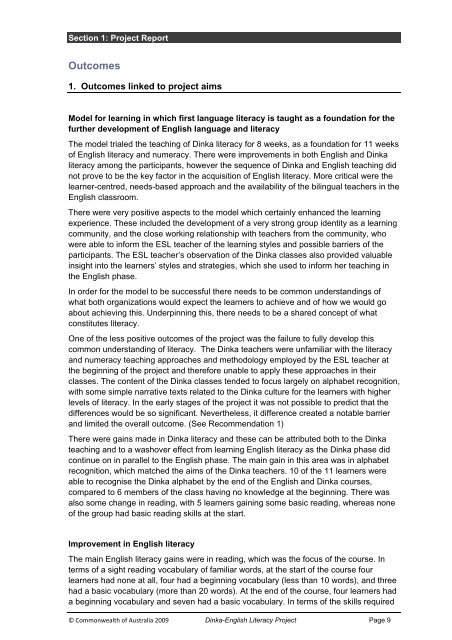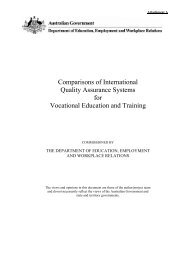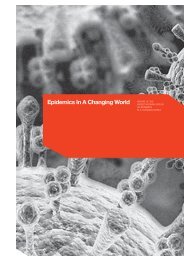First Language (Dinka) Literacy as a Foundation for English ...
First Language (Dinka) Literacy as a Foundation for English ...
First Language (Dinka) Literacy as a Foundation for English ...
Create successful ePaper yourself
Turn your PDF publications into a flip-book with our unique Google optimized e-Paper software.
Section 1: Project Report<br />
Outcomes<br />
1. Outcomes linked to project aims<br />
Model <strong>for</strong> learning in which first language literacy is taught <strong>as</strong> a foundation <strong>for</strong> the<br />
further development of <strong>English</strong> language and literacy<br />
The model trialed the teaching of <strong>Dinka</strong> literacy <strong>for</strong> 8 weeks, <strong>as</strong> a foundation <strong>for</strong> 11 weeks<br />
of <strong>English</strong> literacy and numeracy. There were improvements in both <strong>English</strong> and <strong>Dinka</strong><br />
literacy among the participants, however the sequence of <strong>Dinka</strong> and <strong>English</strong> teaching did<br />
not prove to be the key factor in the acquisition of <strong>English</strong> literacy. More critical were the<br />
learner-centred, needs-b<strong>as</strong>ed approach and the availability of the bilingual teachers in the<br />
<strong>English</strong> cl<strong>as</strong>sroom.<br />
There were very positive <strong>as</strong>pects to the model which certainly enhanced the learning<br />
experience. These included the development of a very strong group identity <strong>as</strong> a learning<br />
community, and the close working relationship with teachers from the community, who<br />
were able to in<strong>for</strong>m the ESL teacher of the learning styles and possible barriers of the<br />
participants. The ESL teacher’s observation of the <strong>Dinka</strong> cl<strong>as</strong>ses also provided valuable<br />
insight into the learners’ styles and strategies, which she used to in<strong>for</strong>m her teaching in<br />
the <strong>English</strong> ph<strong>as</strong>e.<br />
In order <strong>for</strong> the model to be successful there needs to be common understandings of<br />
what both organizations would expect the learners to achieve and of how we would go<br />
about achieving this. Underpinning this, there needs to be a shared concept of what<br />
constitutes literacy.<br />
One of the less positive outcomes of the project w<strong>as</strong> the failure to fully develop this<br />
common understanding of literacy. The <strong>Dinka</strong> teachers were unfamiliar with the literacy<br />
and numeracy teaching approaches and methodology employed by the ESL teacher at<br />
the beginning of the project and there<strong>for</strong>e unable to apply these approaches in their<br />
cl<strong>as</strong>ses. The content of the <strong>Dinka</strong> cl<strong>as</strong>ses tended to focus largely on alphabet recognition,<br />
with some simple narrative texts related to the <strong>Dinka</strong> culture <strong>for</strong> the learners with higher<br />
levels of literacy. In the early stages of the project it w<strong>as</strong> not possible to predict that the<br />
differences would be so significant. Nevertheless, it difference created a notable barrier<br />
and limited the overall outcome. (See Recommendation 1)<br />
There were gains made in <strong>Dinka</strong> literacy and these can be attributed both to the <strong>Dinka</strong><br />
teaching and to a w<strong>as</strong>hover effect from learning <strong>English</strong> literacy <strong>as</strong> the <strong>Dinka</strong> ph<strong>as</strong>e did<br />
continue on in parallel to the <strong>English</strong> ph<strong>as</strong>e. The main gain in this area w<strong>as</strong> in alphabet<br />
recognition, which matched the aims of the <strong>Dinka</strong> teachers. 10 of the 11 learners were<br />
able to recognise the <strong>Dinka</strong> alphabet by the end of the <strong>English</strong> and <strong>Dinka</strong> courses,<br />
compared to 6 members of the cl<strong>as</strong>s having no knowledge at the beginning. There w<strong>as</strong><br />
also some change in reading, with 5 learners gaining some b<strong>as</strong>ic reading, where<strong>as</strong> none<br />
of the group had b<strong>as</strong>ic reading skills at the start.<br />
Improvement in <strong>English</strong> literacy<br />
The main <strong>English</strong> literacy gains were in reading, which w<strong>as</strong> the focus of the course. In<br />
terms of a sight reading vocabulary of familiar words, at the start of the course four<br />
learners had none at all, four had a beginning vocabulary (less than 10 words), and three<br />
had a b<strong>as</strong>ic vocabulary (more than 20 words). At the end of the course, four learners had<br />
a beginning vocabulary and seven had a b<strong>as</strong>ic vocabulary. In terms of the skills required<br />
© Commonwealth of Australia 2009 <strong>Dinka</strong>-<strong>English</strong> <strong>Literacy</strong> Project Page 9
















